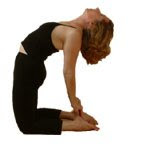There are a myriad of ways to vary a yoga pose. Most tools to vary a pose change the structure of the pose to accommodate the current state of your body. Several common tools to vary a pose are a blanket, block, and strap. Here’s a few ways these tools can enhance your yoga practice:
Blanket –
- A blanket folded several times can be used in forward seated poses to lift the hips higher than knees and tilt the pelvis appropriately to bend forward (tail bone back toward the wall behind you and tops of the hips forward).
- During deep relaxation, a folded blanket can be used under the knees to enable a micro-bend that alleviates stress on the lower back and allows the student to relax more fully.
- In shoulder stand, a folded blanket can be leveraged to keep your seventh cervical in your neck from being overly stressed during the pose by keeping your shoulders and seventh cervical on the blanket while the head rests on the floor.
Block –
- A block can be used as an extension of your arm in a variety of poses from triangle to half moon pose. You can use any edge of the block so that you can more comfortably place your body in better alignment during a pose. It is better to find good alignment with a block than to risk over-extending the body to achieve poor alignment in a pose and risk injury.
- A block makes for a great prop for supported bridge pose. You can begin using the lowest edge of the block and then ease your way to the highest edge of the block over time. The block rests on the flat part of your sacral area, not pressing on the tail bone or on near the waist.
- In sleeping tortoise pose a block can be used to elevate the feet stretching the hips a bit more fully.


Strap –
- A strap can be an extension of your arm or your leg in many poses. The picture of sleeping tortoise pose above shows how a strap can be used to extend the reach of your arms. This helps one to feel the alignment of the arms fully behind the back even though the fingers can’t be interlaced behind the back, opening the shoulders.
- In sleeping big toe pose, a strap allows the student to fully extend their leg straight and experience a deeper stretch in the hamstring and the inner thigh. .
Variation without Props –
Of course, there are ways to vary poses without props that allow a student to be in better alignment and receive the benefits of the pose more fully. For instance:
- Bend the knees while forward bending – Whether you are doing standing or seated forward bends, you can bend your knees as much as needed to better align your back. In the standing forward bend shown, you want to bring your belly towards your thighs to align the lower back (don’t round the lower back to achieve your reach), protecting the back and the hamstrings. It is more important to align the lower back properly with bent knees than to keep the knees straight and risk injury to the hamstrings or lower back.
- Bend your elbows – In the example of cobra pose shown, the elbows are slightly bent to help keep the hips toward the floor and ease the stress on the lower back. Over time, as the lower back becomes more flexible, one can straight their arms.
- Ease up – It is not necessary or recommended to go so deep in a pose that you lose your alignment or your breath. In triangle pose, using a block to extend the length of the arm may not keep the lateral alignment of your body. In this case, easing up and using the hand on the shin can keep the lateral alignment while gaining the benefits from the pose.
 Variations and props are important tools to make yoga fit you. It is not “giving in” to use props or to vary your pose; it is honoring your body, mind, and spirit in the moment. Be present, be healthy!
Variations and props are important tools to make yoga fit you. It is not “giving in” to use props or to vary your pose; it is honoring your body, mind, and spirit in the moment. Be present, be healthy!Namaste,
Leslie Ottavi








No comments:
Post a Comment